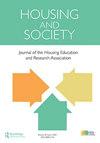在城市中寻找居住的地方:分析坎帕拉的居住选择
Q2 Social Sciences
引用次数: 3
摘要
摘要人们不断地在乌干达的坎帕拉及其境内流动。在选择定居地时,他们必须在几种住房偏好和社会经济状况施加的限制之间找到平衡。此外,由于城市结构的原因,他们的选择可能有限:他们的住房偏好可能在他们喜欢的地方不可用。本文基于2018年在大坎帕拉大都会区收集的2058项调查数据,分析了家庭的社会经济状况对居住偏好的影响,以及这些偏好如何与城市现有形态相互作用。使用回归和空间聚类分析,结果表明,某些社会经济因素,如家庭组成、教育水平和乘坐私家车旅行,是揭示住房属性偏好的良好预测因素。响应家庭考虑的是关系位置(以旅行时间或上班/上学的距离衡量),而不是到市中心的距离。此外,虽然住房属性显示出明显的空间聚类模式,但家庭属性的情况则不然。住房选择的不均衡分布以及住房选择的限制似乎并没有限制家庭公平进入坎帕拉,尽管建议在更精细的地理位置和一段时间内进行更多的研究来捕捉动态。本文章由计算机程序翻译,如有差异,请以英文原文为准。
Finding a place to live in the city: analyzing residential choice in Kampala
ABSTRACT People are constantly moving to and within Kampala, Uganda. When choosing a place to settle, they have to find a balance between several housing preferences and constraints imposed by their socio-economic situation. Moreover, their options might be limited because of the city’s urban fabric: their housing preferences might not be available at their preferred location. This article analyzes the influence of households’ socio-economic situations on residential preferences and how these preferences interact with the existing morphology of the city, based on data from 2,058 surveys in the Greater Kampala Metropolitan Area collected in 2018. Using regression and spatial clustering analysis, results show that certain socio-economic factors such as household composition, education level, and traveling by private car are good predictors of revealed preferences regarding housing attributes. Responding households consider relational location (measured as travel time or distance to work/education) more than distance to the city center. Furthermore, while housing attributes showed clear patterns of spatial clustering, this was much less the case for household attributes. An uneven distribution of housing options together with residential choice constraints do not seem to limit households’ equitable access to Kampala, although more research at a finer geography and over time is recommended to capture the dynamics.
求助全文
通过发布文献求助,成功后即可免费获取论文全文。
去求助
来源期刊

Housing and Society
Social Sciences-Urban Studies
CiteScore
2.30
自引率
0.00%
发文量
10
期刊介绍:
Housing and Society is the journal of the Housing Education and Research Association (HERA). The journal supports the mission of HERA by providing for the dissemination of research and other scholarly work. Submissions from a broad range of perspectives are encouraged. Topics in housing include: policy, design, social aspects, gerontology, behavioral aspects, energy/environment, equipment, interiors, economics, theory/model development, education, and program development or evaluation. The journal welcomes the submission of original research articles, notes and commentaries. Notes are shorter manuscripts presenting succinct information on housing related to one of the following categories: - Research: exploratory or not heavily theory-based or statistically analyzed - Academic: innovative teaching ideas - Program: development, implementation, and/or evaluation of Cooperative Extension or other housing programming efforts - Policy: examination of policy impact, comparative analysis, and/or need to achieve housing goals - Reviews: books, documentaries, etc.
 求助内容:
求助内容: 应助结果提醒方式:
应助结果提醒方式:


